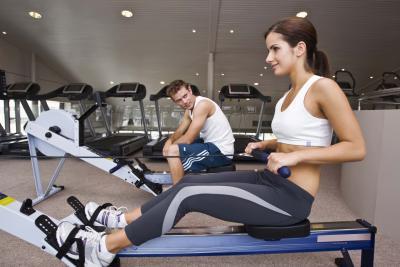
Calculating the calories burned on a rowing machine can be very difficult and it is a question that often comes up.
Rowing machine calories burned while working out are difficult to calculate because there are so many factors in the calculation such as age, weight, heart rate, intensity, time, etc.
In this article, I hope to go over exactly how to calculate calories burned while rowing, how to burn the most calories, and other factors that contribute to burning calories and weight loss.
Overview of Calculating Calories Burned
To understand rowing machine calories burned we first must understand the calorie themselves. Such as how many calories we burn just being alive and how to calculate the number of calories burned in a workout.
We can then discuss how many calories are burned while rowing and how to maximize this amount.
This will then help us answer the question: “Will rowing help me lose weight?”
The answer, of course, is yes and answered more thoroughly in the linked article.
What is a Calorie?
A calorie is a unit of measurement used to measure energy. When doing any activity you are using energy. Thus the number of calories used can be thought of as the amount of energy exerted.
A calorie (kcal) by definition is the amount of energy needed to raise the temperature of 1 kilogram of water 1 degree Celsius.
How to Burn a Calorie?
The body burns calories in many different ways such as eating, digestion, breathing, repairing cells, working out, etc.
Your basic daily bodily functions make up about 70% of calories burned and this can be defined as our metabolism or Basal Metabolic Rate (BMR).
The other 30% of calories burned is from physical activity or “working out” and food processing (digestion). Calories burned from food processing remain pretty much steady, but I will explain later how you can increase this by eating multiple smaller meals a day.
Calories burned from physical activity are the most variable and easiest to increase.
So to burn more calories, you must increase BMR and physical activity. Both can be achieved through a rowing machine!
How Many Calories Equal 1 Pound?
3,500 calories equal 1 pound. So a person must have a deficit of 3,500 calories to lose 1 pound of fat.
For example, if you eat a 2,200-calorie diet a day, have a Basal Metabolic Rate of 1,900 calories per day, and row for 45 minutes to burn 800 calories, then you would create a 500-calorie deficit for the day.
2,200 (Eating) – 1,900 (BMR) – 800 (Working Out) = -500 calorie deficit
If you did this for 1 week you would have created a 3,500-calorie deficit and lost 1 pound.
Calculating Your Basal Metabolic Rate (BMR)
Calculating your basal metabolic rate (BMR) will give you a good idea of how many calories your body burns just performing normal daily functions.
You can visit the link at BodyBuilding.com and enter your info to get your BMR. They also list out the formula used in case you are interested in the numbers.
The BMR calculated is not 100% accurate because it is just taking your weight and not calculating lean muscle mass vs. fat. A 185-pound man who has 5% body fat will have a much higher BMR than a 185-pound man with 20% body fat. More on this below.
Calculating Calories Burned During a Workout
According to the Journal of Sports Science, the below formula will calculate how many calories you burn during a workout.
Men use the following formula:
Calories Burned = [(Age x 0.2017) – (Weight x 0.09036) + (Heart Rate x 0.6309) – 55.0969] x Time / 4.184.
Women use the following formula:
Calories Burned = [(Age x 0.074) – (Weight x 0.05741) + (Heart Rate x 0.4472) – 20.4022] x Time / 4.184.
Here is a link to a fitness calculator that will do the above calculation for you.
Unfortunately, the formula requires you to calculate your heart rate during the workout. Some rowing machines come with a heart rate monitor or you can purchase one separately.
Here is a list of the best heart rate monitors you can use.
Once you have your BMR calculated and you can accurately calculate calories burned during a workout, you will have your total daily calories burned.
Maximizing Rowing Machine Calories Burned
After providing a little background on calculating calories burned, I have compiled a bunch of data to give you a good idea of how many calories you burn while on a rowing machine.
How Many Calories Does a Rowing Machine Burn?
First, I took data from various sources and studies across the web. Then I averaged the numbers together to hopefully come up with an accurate answer.
| Weight (Lbs) | Intensity | Time (Hours) | Calories Burned |
|---|---|---|---|
| 125 | Moderate | 1 | 410 |
| 125 | Vigorous | 1 | 510 |
| 155 | Moderate | 1 | 520 |
| 155 | Vigorous | 1 | 632 |
| 185 | Moderate | 1 | 622 |
| 185 | Vigorous | 1 | 754 |
| 240 | Moderate | 1 | 654 |
| 240 | Vigorous | 1 | 795 |
Keep in mind these numbers will vary from person to person because the formula takes into account age, weight, and heart rate.
If you are out of shape, your heart rate will be higher and you will burn more calories.
A fit man, weighing 185 pounds, who rows for 1 hour will burn fewer calories than the same man rowing if he were out of shape. This is because the out-of-shape man has to exert more energy to complete the same workout.
Rowing Machine Monitor Calculating Calories
Your rowing machine fitness monitor will calculate the calories burned on your rowing machine.
However, this is just an estimate and every manual states that this number should only be used to compare workouts.
As stated above, calculating calories burned is very difficult and varies from person to person. Calculating calories burned from a rowing machine workout includes a lot of factors like a rower’s age, weight, heart rate, intensity, time, lean muscle mass, etc.
The more expensive the rowing machine, the better the monitor and calorie calculator. For example, the Concept2 Model D and E PM5 monitor does a great job calculating rowing machine calories burned.
The world's best-selling rowing machine. Adjustable air resistance & easy storage. Comes with a device holder for your smartphone. You can't go wrong with this rowing machine.
- Best overall rowing machine on the market
- Connects with heart rate monitors
- 5 year frame warranty
- Fan can be too noisy for some
- Not the cheapest
Some rowing machine monitors can overestimate actual calories burned by over 40%. That is why in some of my other articles I state that a rowing machine can burn 1,000 calories per hour. This is just to make an apples-to-apples comparison of say an elliptical to a rowing machine monitor.
High Intensity Interval Training (HIIT) vs. Steady-State
When it comes to working out there are 2 main ways to train on a rowing machine, High Intensity Interval Training (HIIT) and Steady-State. Here are examples of each to understand the difference:
Steady-State:
- Adjust the rower to a medium resistance (about 60-70% of your max capacity)
- Begin rowing at what you consider a medium pace
- Keep this pace for 30-45 minutes aiming for a heart rate of 120-150 beats per minute
HIIT:
- Row for 2-3 minutes at a medium level (about 60-70% of your max capacity)
- Sprint or row as hard as possible for 1 minute (90-100% of your max capacity)
- Rest for 1 minute or longer by rowing slowly until your heart rate comes back down
- Repeat for 20 minutes or your desired time
So which workout burns more calories?
Again, it is very tough to determine because of all the factors that play into the equation for burning calories.
When rowing in steady-state you can row for a much longer time but your heart rate is not as elevated. While performing HIIT, your heart rate is much higher but it may be harder to row for 45 minutes at that level.
HIIT workouts also have something called “afterburn” or Excess Post-Exercise Oxygen Consumption (EPOC).
This is where your body has to increase its rate of oxygen intake to account for the oxygen deficit after a strenuous workout and help return your body to its resting state.
This “afterburn” effect can raise metabolic rates for hours after a workout and can continue to burn 100-200 calories more after you finished your rowing routine.
Due to the fact that it is hard to determine which workout is better, I like to incorporate both workouts into my rowing routine. Incorporating both workouts will actually lead to you burning more calories in the long run anyway! I go into this further in the next section.
How to Burn the Most Calories While Using a Rowing Machine?
There are a few tips and data-backed techniques to help you burn the most calories while using a rowing machine.
The first tip is to focus on your stroke rate or the number of full rowing motions. This doesn’t mean just sliding up and down the rail as fast as possible but it means getting your flywheel to spin faster or create more power.
Focus staying at a stroke per minute rate of 24-30 spm. This is the sweet spot where you will burn the most calories.
I was able to find a study done on Rowing Speed vs. Calories Burned that showed as you row faster, the number of calories you burn increases exponentially.
WaterRower explains this as the Rule of Cubes- “The rule of cubes, therefore, dictates that a doubling of the speed of the boat will require an eight-fold increase in resistance.”
Basically, to go a little faster on a rowing machine requires a lot more energy and calories.
(Source: http://ctowncrossfit.com/wp-content/blogs.dir/36/files/2014/12/Rower-Data.pdf )
Another great tip to help you burn the most calories while rowing is to switch up your workouts. Alternating your routine every 2 weeks – 1 month will help your body not become “accustomed” to your workout routine.
The more you do the same routine, the more efficient your body becomes at performing the workout. The more efficient your body is at performing your workout, the lower your heart rate will be during the workout and thus you will burn fewer calories.
Other Weight Loss Features
Building Lean Muscle to Burn Calories
Building lean muscle will help you burn more calories throughout the day by increasing your BMR.
When you enter your weight to calculate your BMR you do not enter your body fat % which is why the number is slightly off.
Studies show that 1 pound of muscle burns 5-10 calories per day, while 1 pound of fat burns ~2 calories per day. So as I mentioned before, a 185 pound man who has 5% body fat will have a much higher BMR than a 185 pound man with 20% body fat.
Rowing machines are a great way to build lean muscle because it incorporates resistance training with a great cardiovascular workout. So not only does rowing burn calories while you row, but it can actually lead to you having a higher metabolism overall!
Why You Must Diet and Exercise to Lose Weight
To lose weight properly a person must exercise and diet. Exercising allows a person to gain muscle, keep their bone density, and ensure the weight they are losing is fat and not muscle mass.
Exercising has a lot of other benefits that contribute to health and weight loss like better sleep patterns, lower cholesterol, lower blood pressure, and lower stress levels.
Most health professionals estimate that diet accounts for 75-80% of weight loss.
Diet is the most important aspect of losing weight because it is much easier to cut calories out of your life than to burn them off exercising.
For example, if a person cuts out 1 can of soda and 3 cookies from their diet a day, that is 300 calories, or about 30 minutes on a rowing machine!
Eating healthier foods, such as vegetables, also helps your body increase its metabolism and burn calories while it digests the food. One possible way to increase the amount of calories burned from eating is to eat 6 smaller meals a day instead of 3 large meals. This will help your body keep its metabolism up longer throughout the day and burn more calories.
Combining diet and exercise is obviously the best way to lose weight. Cutting out a few unhealthy food items and exercising for 30 minutes a day will help you create a big enough calorie deficit to lose well over 1 pound a week!
Main Takeaway
Calculating rowing machine calories burned can be very difficult but it is a very common question that most rowers have.
I believe understanding the whole picture of how calories play into your life is important because weight loss is more than just burning calories during a workout.
So here are my main takeaways from this article:
- Calculate your BMR to understand how many calories your body burns per day at a resting state
- Accurately calculate calories burned while rowing and do not rely solely on your fitness monitor
- Switch up your workouts and row “fast” to help burn more calories
- Build lean muscles from rowing, eat a healthy diet, and cut out high calorie junk food
- Try to create a calorie deficit of 500 calorie per day to lose 1 pound a week
If you are looking for the best rowing machine to burn calories, I would recommend reading my Concept2 Model D Indoor Rower review.
This is the #1 bestselling rowing machine with the most advanced and accurate monitor. It is also used in every Crossfit gym and used by almost every Olympic Rowing athlete.
I also have a few articles that could be of interest to you if you found this article helpful:
If you have any questions about losing weight with a rowing machine or what model to purchase, please leave them in the comments section below!


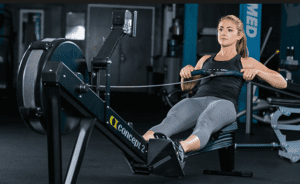
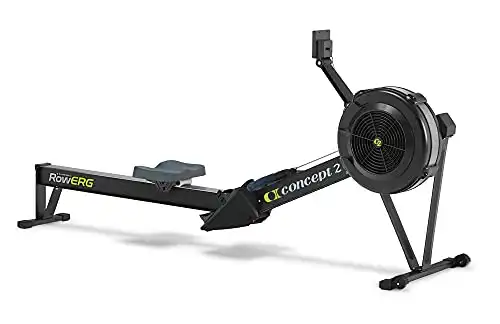
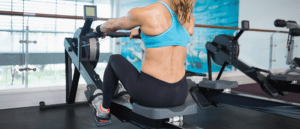
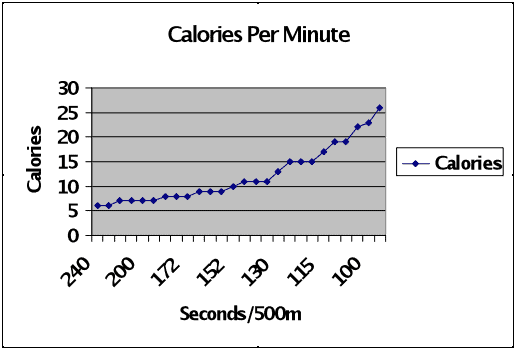

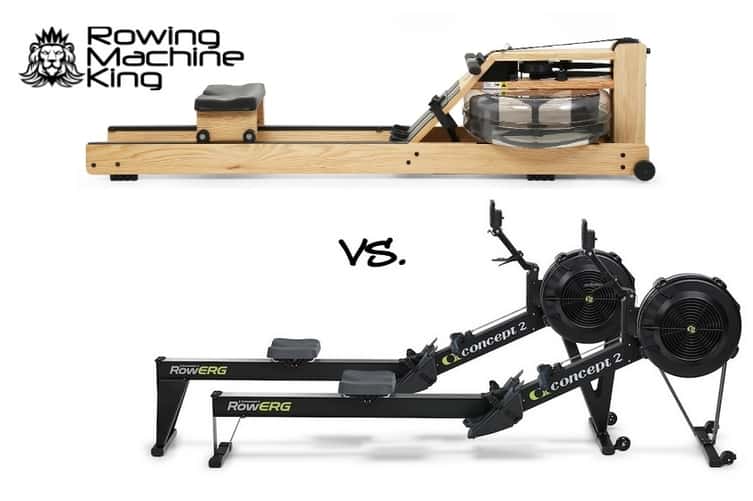
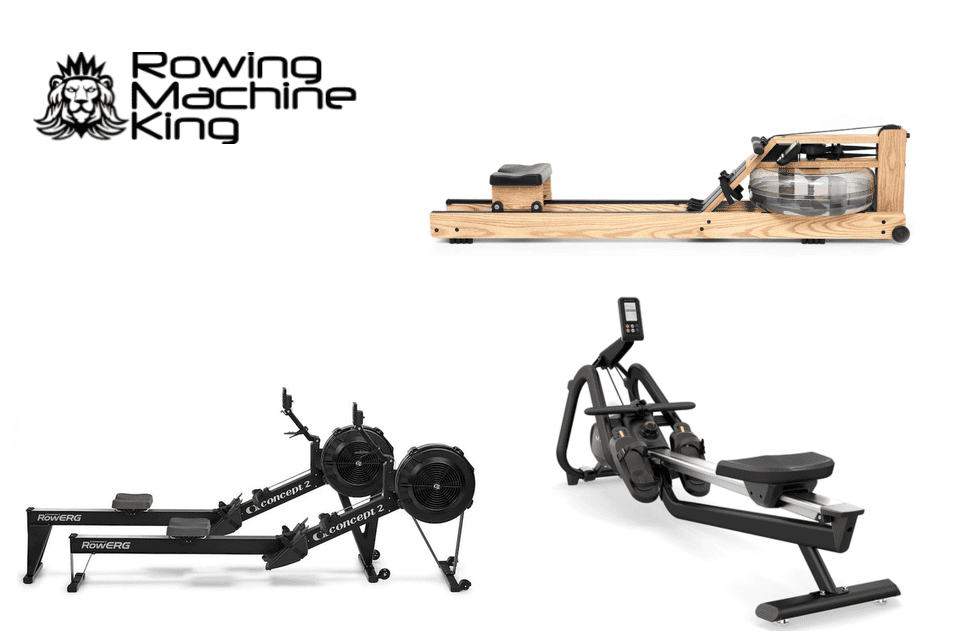
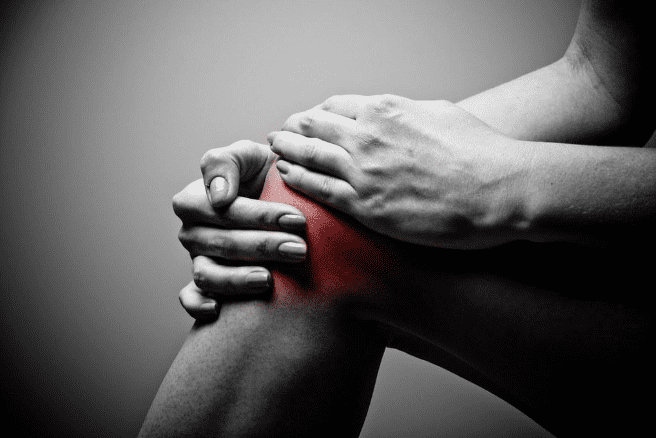
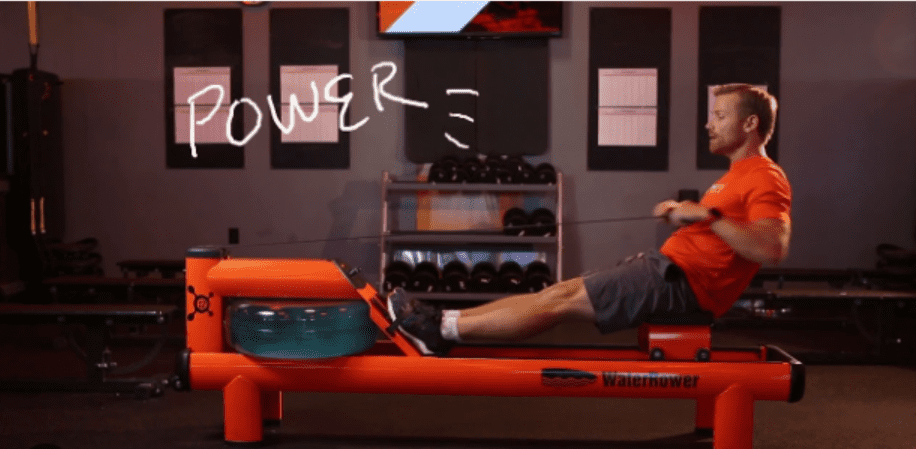
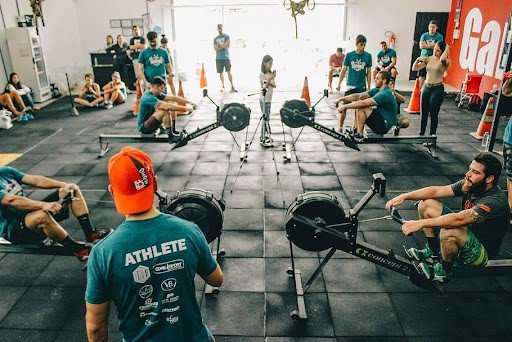
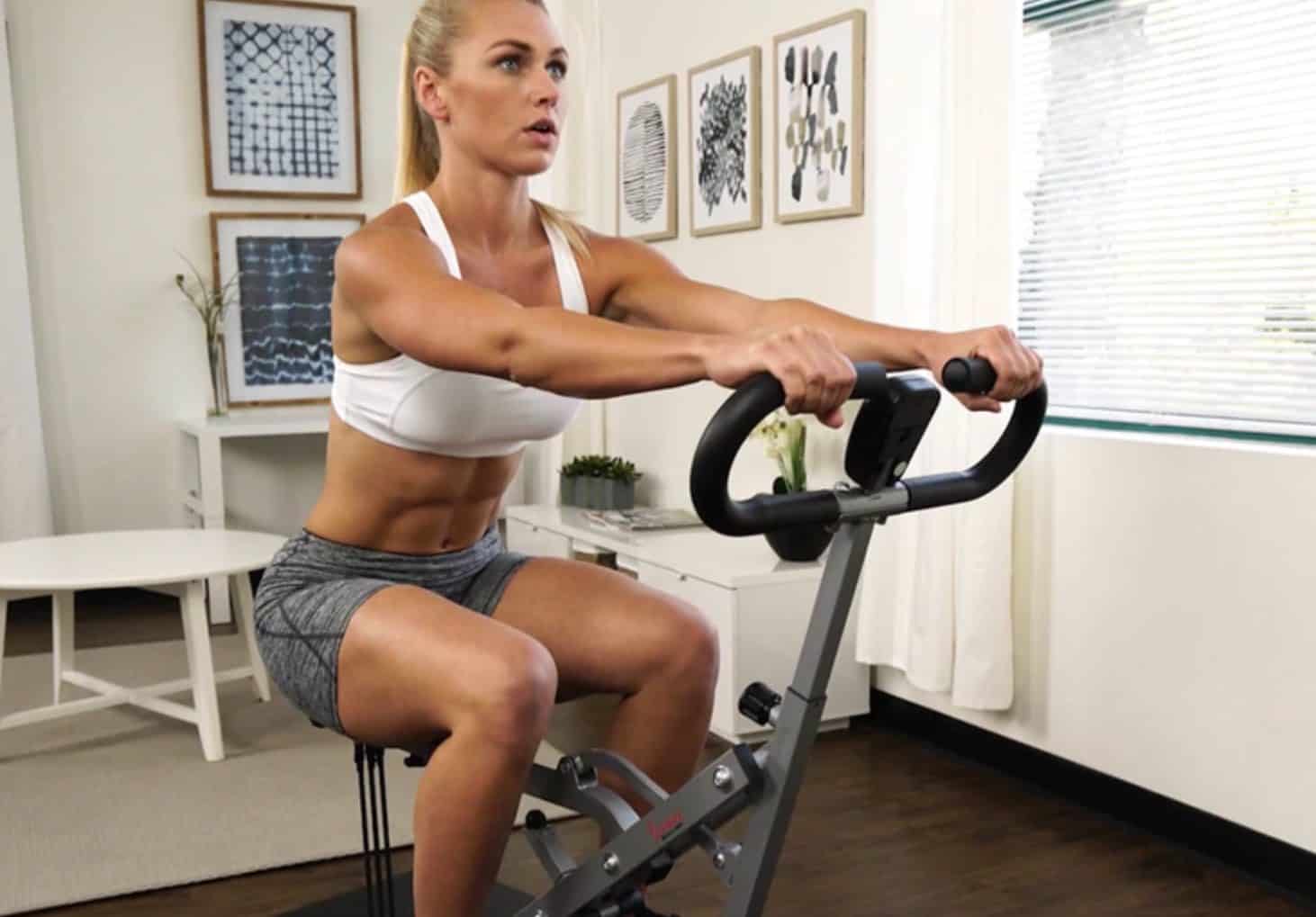
Hi
I’m a 59-year-old male, 80kilos / 176lbs for 5’10”.
I want to get my weight down to 76kilos / 165lbs – pretty modest goal.
My plan is to do it largely by rowing on the Concept 2 at the gym. I have a rowing machine at home, but I find it much easier to get motivated when other people are working out too.
So, as 1 kilo is about 7000 calories I plan on doing 50 sessions burning 1000 calories each time, before Christmas. ( 50 sessions is 50 000 calories, equivalent in theory to 7 kilos, so II’m giving myself some leeway. )
I had a false start before the summer vacation, when in June and July I chalked up 11 sessions.
Since the holidays, in about the last ten days I have done 6 sessions for a total of 6000 calories, according to the Concept 2 computer.
When I first started, before the vacation, I did 1000 calories straight through, without a pause. I don’t bother looking at distance or watts, just at calories. It took me over 90 minutes and I was totally washed out. I realised that I was getting seriously dehydrated and so I changed my approach – at 250, 500 and 750 calories I now stop for thirty seconds or so, and drink water, and sometimes eat. When you pause like this, the timer on the Concept 2 pauses and resumes again where you left off as you start pulling. So the reading immediately went down to 86 minutes, not including the three pauses. I felt much better afterwards.
Since re-starting after the holidays, I’ve rapidly got into the swing. On sessions 1 to 3 I was taking about 86 minutes. On 4, I took over 90 minutes and I was whacked out- I was clearly overdoing it. So I had 2 rest days, came back and did it in 84 minutes. Today, I did it in under 82 minutes and I’m confident I can go under 80 minutes ( that’s an average rate of 750 calories per hour.) Today at each of the 250 and 500 pauses I ate a banana and had a protein drink – I felt the benefit and could see it in the time.
People ( Gary Taubes, notably ) point out that exercise like this strongly stimulates appetite and consequently people don’t lose weight as they eat to compensate. There is truth in this, but I find my appetite is stimulated to eat healthy food. I don’t have cravings for sugar – before I got into training I could eat a litre of ice cream and a tube of Pringles. Now I’m in training the very thought is slightly off-putting.
Another aspect is sleep – I have no problem sleeping when I row for over 80 minutes. And the consensus today apparently is that good sleep is critical for hormonal balance and weight control.
I’d be interested to know if anyone else is trying a similar approach. I imagine a lot of people would find it too tedious, but I enjoy the rhythm and doing mental arithmetic calculations as I look at the monitor, or listen to the audio book on my phone. ( I’ve got “The Stand” by Stephen King at the moment – perfect, nearly 50 hours long! )
Manuel,
Awesome, sounds like you are really getting after it! I think everything you said makes sense and at the most basic levels, losing weight is a simple math problem (Calories In – Calories Out = Total Calories). You seem to have the “calories Out” portion down with all that hard work!
You are also correct when you say some people eat more when they work out. I do notice that exercise can stimulate people to eat, especially when they run for 20 minutes, then think they earned “pizza and ice cream”. Only problem is the running may have burned 300 calories but the pizza & ice cream added 1,000 calories, causing a net gain of 700 calories. This is where people can start seeing weight gain from working out.
Weight loss is definitely more than just counting calories and you hit on it with items such as proper rest and hormonal balance. Stress is another huge factor that contributes to weight gain and intertwines itself with everything else that is unhealthy. There are also other small tricks that can be done like jump starting your metabolism in the morning, adding lean muscle, and different HIIT exercises that will help burn more calories when not working out.
I read a book called the “4-Hour Body by Tim Ferriss” that talked about some of these weight loss “hacks” and different diets. I found it to be really interesting and one section even talked about a man who did nothing but take ice baths to lose weight. His approach was the basic “calories in minus calories out” formula and the laws of thermodynamics stating that we burn more calories when cold. It’s definitely not the “be all end all” of dieting and it even managed to piss a lot of people off, but I found it to be a good read.
I guess to keep it simple people should exercise daily, eat healthy (a lot of vegetables, mostly green), sleep enough, and stress-out less!
Thank you for the great detailed comment! Let us know how you progress!
Manuel, don’t know if you are still doing this but I do something very similar. I generally row for an hour and consume about 850 calories on average, today 869, a good day. I sometimes do try the 1000 calorie system you mention and that takes about 70 minutes. I am 5 feet nine and weigh 156 pounds (70 kilos) which I am completely happy with. I lost a lot of weight when I first stopped working but this has stabilised. I do a lot of hill walking outside the gym stuff and I have found the rower to be the perfect training instrument. Keep up the good work.
Mick
I am a 64 year old woman. I didn’t do any sport for 35 years. I started weight lifting 9 years ago which led to boxing and cardio: rowing machine and bike. I gave up after 5 years but returned a year later. Also returned to competition tennis after 35 years: have tennis elbow; but have mostly overcome it reducing my tennis from 2 or 3 times a week to once a week. Also with the Low Fodmap diet for IBS, I’ve cut out all the rubbish food and lost 6 kilos in 6 months…still steadly losing slowly and feeling great.
Wow Barbara, sounds great!! Thank you for sharing your story!
Any tips about losing weight and rowing would be greatly appreciated :)
At that age it is necessary to consume as much as you like, in order to feel healthy
Not true. Just because you’re a certain age doesn’t mean you can consume as much as you want. You have to watch the intake even closer as the metabolism has slowed and gaining weight is easier now. I bought a rowing machine in April of 2017 and between that, the treadmill and Daily Burn they help keep me in shape. I bought a water rower and totally love it and the sound it makes when rowing. It’s a beautiful piece of furniture that I keep in my dining room. I just turned 60 and I’m 5’6″ and weigh 126. I exercise regularly and try to maintain a somewhat healthy diet.
I’m 68 and just started crossfit! I lost 40lbs first cause my knees were an issue from the weight. I eat healthy and limit myself to one or two cheats a month. I love the rowing machine and just did 2000m for the first time. It took me 12 minutes but I am pleased that I was able to do it
I am a 43-year-old woman and I enjoy running/jogging, insanity, and some yoga. I want to try rowing as an good low impact, full body workout that I can do in my house. (Running is tough because my treadmill is in my garage and during the hot Las Vegas summers and cold winters it is tough to get motivated.) I am looking for a good rowing machine for in my house that does not cost too much. Can anyone recommend a good home-use, beginner-friendly rowing machine under $800? Thank you! Great article!
Hi Kathy,
I would be glad to help. Visit my Personal Rowing Concierge page and fill out the form.
I will help point you in the right direction of a great rowing machine!
Hi Edwin :)
Thank u for the great article.
Would you say thet indoor rowing is the same as outdoor?
We have this discussion at work and cannot agree. We have an air restistance rowing machine. So if to assume that the parameters were spmewhat the same, like medium windy for example, would the person burn the same amount of kcal? I have an idea that the person would use more energy when rowing on water and trying to balance ant the same time.
Thank u in advance for your opinion :)
That is a very good question and one that doesn’t have a specific study done about it! I guess I can take a crack at it and play a little devil’s advocate.
In the case for outdoor rowing burning more calories, I would agree that a person would burn an additional amount of calories by having to engage their core at all times to keep the boat stable. It is also possible that a person can row longer outdoors due to them not getting as bored just starring at a monitor. Sort of like how many people cannot run a marathon on a treadmill but could do so outside. However, space is a limiting factor and it is difficult to row outdoors for an hour straight at high intensity but easy to do on an indoor rower.
When rowing indoors you do not have to engage your core as much unless you are on a static erg like the RowPerfect RP3. However, due to you not having to balance and perform perfect technique, you tend to be able to exert more force on your stroke. This could lead to a higher calorie burn rate. It is also very easy to row a marathon indoors or row for longer periods of time. Another factor could be that rowing while looking at a monitor keeps you “honest” and on track to stay a certain pace or kcal/hour. This could give you an edge rowing indoors unless you have a HRM outdoors and are staying in a specific heart rate zone.
One question would be, is the discussion based on calories burned in a 2k, in 1hour, or in general? There was one study done by the Wisconsin Department of Health and Family Services that said rowing on water vigorously burns 844 calories per hour if you weigh 155 pounds. A Harvard study then stated rowing stationary vigorously for 1 hour at 155 lbs. will burn 632 calories. Unfortunately, each study only did indoor or outdoor rowing and not both, so its hard to say the results can be compared.
I also don’t trust the Harvard study because I currently weigh ~155 lbs. and I just happened to finish a 1 hour session on my C2 rowing lightly (2:20 split) and burned 710 calories. So I can only imagine I would burn more than 1,000 if I was rowing vigorously.
Sorry I don’t have a very good answer! I just started typing some of my thoughts on the topic and this is what I came up with. I would love to hear if you come up with some concrete evidence! Thanks for stopping in and asking my opinion :)
Hi, I started in January after putting on 5 stone over the last 3 years after taking an office job. I love the rower and the bike. I started at 339lbs. Im now down to 296lbs. Long way to go, but this is a life style change for me. Didn’t realise how much I could get away without exercising when I had an active job on my feet.
What I find useful for me is I set myself monthly goals. But as you know things come into play, for example end of January I was in Paris for 4 days with the girlfriend. But I set that as a target to work hard for. I have cut alcohol out unless it’s a special occasion but I’ve substituted cider for vodka diet cokes. Still not great but it’s a reward that’s a lot better off for you.
Food wise I have an MBR of 1980 calories. I consume around 1800-2000 calories a day but exercise to burn around a 1000 calories after work to create my deficit. In the gym I started just managing a 1000ms on the tower, I now do 6k and building it up. I also cycle 10 miles in the gym too. Weekends are my days off for the gym but involve a bike ride and taking the dog on a hike. My fitness pal app helps me track everything and if I only lose 1lb in a week, it’s a lb off!! Good luck to everyone that’s got different goals. Try to see it as a lifestyle change and not just a way to lose weight and you will get there without noticing. It’s working for me :)
Awesome Mike! Glad to hear you are seeing big progress with the rowing machine! I think tracking and measuring data is a big key to success, like you are doing.
Cutting out alcohol is one of the best ways to cut calories out of a diet and is hugely beneficial overall. It’s nice to wake up on a weekend without a hangover and be able to get a workout in haha. Like you said, drinking beer ads too many calories and if you are going to drink, hard alcohol is the best.
Good luck and keep at it!
Hello! Awesome article btw! I am starting to workout with a rower because I am tired of the treadmill and I want to do something new! How about the after burn effect? Does working with a rowing machine will create that effect?
Hi Vicky!
Glad to hear you enjoyed the article and rowing! Yes, the rowing machine is excellent for creating the “after burn” effect.
Most HIIT (high intensity interval training) exercises are great for the after burn effect but you can argue that rowing is the best. This is due to it being excellent for cardio and building lean muscle. This means you will burn more calories from “excess post-exercise oxygen consumption” (EPOC) and your body repairing the broken down muscles. Plus lean muscle burns more calories than fat throughout the day!
Here is a great article that breaks down everything about the “After Burn” effect. You will see that what creates the “after burn” effect is perfectly provided by a rowing machine.
Let me know if you have any other questions and good luck!
Good article, thanks. to mix things up i’ll throw in a workout for calories, it takes a lot longer than you think to crush cals.
So for instance i’ll do a six pack and a meat pie. (6x 146cal + 485cal) it’s a stong reminder that it’s much much easier to not eat a pie than it is to burn a pie :/
Hahaha I like this idea! Maybe I’ll do a “Cheeseburger” this week.
Yeah I understand it’s a lot harder to burn calories than the articles say online. The only problem is so many other articles claim their workouts are so much more effective.
Bottom line is a rowing machine burns more calories than other pieces of fitness equipment if used properly. Hopefully I can get this point across to readers.
Brilliant !!
I loved the article! I was actually looking for calorie consumption on the rower at given paces (not intensities, which are subjective). However I think that we require a three dimensional calculator with weight, pace (seconds/500m) and calories.
I’d like to dig a bit more on your statement “Studies show that 1 pound of muscle burns 9 calories per hour”. I weight 190 pounds and my omrom shows I have 8.4% body fat and 43.8% muscle mass. Let’s assume my omron is massively wrong and I have slightly over 20% muscle mass, which would be around 40 pounds of muscle. This would mean that @ 9 Cal / hour per pound I would burn 360 Cal / hour or 8640 Cal per day only using the standby muscle calorie consumption.
IMO this is very wrong. What is your source? I’d like to take a look.
Thanks,
Rubén.
Hi Ruben,
Thank you for pointing this out! I cannot recall which study I read but I don’t believe it read “9 calories per hour”.
What I meant to write was “9 calories per day”. I must not have caught the mistake because I didn’t actually do the calculation and was only using it to make a point that muscle can have a positive effect on calories burned per day.
Different studies show different results when it comes to the amount of calories 1 pound of muscle burns in a day. Usually they range from 5-10 but so many factors influence these numbers that it is difficult to say.
Here is an article from WebMD that talks about muscles and calories and I did a quick white paper search and found a related study. Sorry I didn’t have much time to do research on this today.
http://www.webmd.com/diet/obesity/features/8-ways-to-burn-calories-and-fight-fat#1
https://www.ncbi.nlm.nih.gov/pmc/articles/PMC296885/?page=1
Thank you for catching this mistake! I will update the article.
One of the best articles on this topic I’ve read so far.
The problem I see around the calculation is that it’s based on the individuum doing sports and the heart rate, only. When I look at things from a perspective of physics there’s an amount of work that has to be done. If you imagine to move a boat outdoors with the person from place A to place B, it will take a certain amount of mechanical work which you can calculate in calories. Same indoors, just a bit harder to imagine.
A highly trained person will do the same amount of mechanical work at a lower heart rate. In the formula it calculates into less calories burned than un untrained person with higher heart rate which cannot be true because the mechanical work executed doesn’t depend on the heart rate of the person doing the work.
Any idea who was trying to take that into the equation ?
Hi Ralph,
I’m no expert on this matter but I believe a highly trained person rowing a boat from point A to B would burn less calories than an untrained person doing the exact same workout. Even if both are doing the same mechanical work. The highly trained person would also recover much faster which also makes their calories burned be less.
There are a lot of factors that go into calculating calories burned and heart rate is one of the easiest ways to get an accurate number but it is not perfect. I think it takes some pretty sophisticated equipment and observations (BMI, age, VO2 max, etc.) to get a highly accurate readout of calories burned.
Thanks for commenting and I’d love to hear your thoughts!
While I agree on the effect on the athlete (trained people recover faster, have a different basic level of energy consumption, etc.), I strongly disagree on the physics side. Take an easier example: a weight of 200 pounds to be lifted will not become lightweight, if a big muscles come along. The strong athlete will make the exercise while others will fail, however the energy needed is the same for each person. Gravity cannot be tricked by more muscles. The same applies to rowing.
So my impression is (as is often the case), we all live with the algorithm, which is easier to calculate, not with the one giving highest individual precision.
Again, I’m no expert, but I believe there is a lot of scientific literature that disproves what you are saying. Two people, who are almost exactly the same, will burn different amounts of calories doing the exact same exercise. While it may look like moving an object from point A to B they are doing the same work, I believe on a metabolic and cellular level they are not.
I would maybe do some research on the topic and read some white papers to see if you can find any supporting evidence. There are a lot of thorough articles on the internet that cover this exact topic.
The net work on the moved person in a boat or virtual person on an erg are the same but the work performed in the body and on the tools of movement are different. In the body specific task trained muscle fibers complete tasks more efficiently. With respect to the machines themselves, a trained person knows form and can hold form more effectively (straight line row, no erratic lifting and dumping hands, arms, shoulders, no front to back core movement that counteracts “forward” movement, all of which expends more energy). Other energy loss on the rower would manifest as vibration of the machine itself in an up and down motion and uneven forward and backward pushing of the machine due to lack of a smooth stroke. On the water, the same erratic movements have the same effect as does the addition of an unbalanced boat which results in drag force up and down against the water on the side of the boat. Additionally, when you are unbalanced on the water oars drag and place up and down force on arms/shoulders which spend energy correcting boat balance and oar height. Many factors contribute to the unequal calorie burn between trained and untrained rowers (and every other physical activity).
A question, on my rowing machine at level 3 I do 200 strokes in 7 minutes 22 seconds 2k. Burning 74 calories.
If I turn it up to level 4 200 strokes 7 minutes 22 seconds. I only do 1.6k burning 66 calories.
Can you explain.
Bob
What type of rowing machine are you using and is it recording heart rate?
The “levels” are measures of resistance which calculate a “drag factor” which can be found and calibrated in the options menu on the PM monitor. The reason it shows you’re traveling less distance and burning less calories is because you aren’t rowing as fast due to a higher resistance. Ergs are meant to try to apply the land-exercise metrics of rowing and apply them to physical distances in traveled in shells (rowing boats).
In a more understandable manner, you aren’t going to do as many reps with a heavier weight. The same applies to rowing (and the stronger you are, you faster you can go on heavier drags). You may want to train at higher drags to increase your rowing-strength if you so desire. A 4-5 resistance range (or 100-120 drag factor) is the base standard of competitive rowers.
Hope this helps.
This is a very detailed and informative article. I will share this info with my mom. She was diagnosed as overweight recently. She’s doing her workout routine every day but I don’t think it’s working. I would recommend this rowing machine to her and see the difference.
We have a grid games on at the moment with Virgin active, my question is we row for 20 seconds and take the calories score from the machine. We have had people say they have scores of between 15 and 20 calories in 20 seconds. I cannot see how this is possible. you have 10 seconds rest and then you on to the next exercise.
If you have some really tough people who would see if this is possible and could they then carry on with burpees 10 seconds later. Just to see if this is possible.
Hi Kim,
This is definitely more of a Crossfit question and I think this article may be helpful: http://crossfitsouth.com/rowing-meters-vs-calories/
Goal, reduce belly fat, waistline 20 lbs.
At 65.5 I am 6’2″ at 230lb with perfect BP, heartbeat. My primary activity is 2mile x 5 day\wk fast walk. I have a folding Row machine. Just started a fortnight ago.
I was told to row with final lean back, body full horizontal, with arms full out over head horzontally, a full extended pull. I do this 10 minutes at fast rate twice daily. Metabolism is up. My diet is 100% sugar free, low carb, high protein, pure water, high vegetable.
My goal is to reduce waistline from 44 to 35.
Any suggestions for rowing or other ideas appreciated.
Hi Robert!
Glad to hear you are adding rowing into your workout routine. It sounds like you are in great shape and have a great diet!
I think the best suggestion is to look up different YouTube videos about workouts you can perform. They key is to not get bored! Concept2 has some great workout suggestions on their site and I think it would be beneficial for you to watch their technique video: https://youtu.be/zQ82RYIFLN8
I’m not exactly sure what you were describing when doing your rowing stroke but it sounds like you are leaning too far back.
Hi Edwin….Love all the information on your site appreciate it.
I am currently looking to buy a Concept 2 Model D Rower Pm5 for $900.00 from Rogue’s website
only they can’t sell me one until early June!! $45.00 for shipping and $55.00 for a Mat is what i would be spending, for a bran new one. Do you know of anywhere I could buy one from sooner.? I would forever be thankful to find one to buy. I live in Milwaukee Wisconsin area, having great difficulty trying to purchase one! I will forever be Grateful if you could help me in anyway Edwin.
Hi Linda – thanks for reaching out! Due to the pandemic most retailers are sold out of Concept2s. The best place to find them are Amazon or Rogue and they will have them in stock as soon as they are available. The other option is to buy a Model E if you find one (slightly more money but functionally the same). Some retailers may have them in stock but they probably increased the price significantly. Sorry I can’t be of better help!!
Bro, i can’t match your math. i believe your formula has a typo.
Men use the following formula:
Calories Burned = [(Age x 0.2017) – (Weight x 0.09036) + (Heart Rate x 0.6309) – 55.0969] x Time / 4.184.
the weight term has to be a positive number to get the same same answer as the calculator on the linked page as well as calculators on similar websites.
Hey Jim! Thanks for the comment – would you mind sending me your inputs to see if I can find the error?
I checked on mine and the formula seems to work.
Hi; the standard formula for calculating calories burned is for people in an upright position. When rowing, you are much more reclined. When more reclined, the heart doesn’t need to fight gravity as much, and consequently, blood is pumped around much more efficiently. It is not the heart rate that determines calories burned, but the amount of oxygen that the heart delivers to the tissue. Time for a better formula ;-)
Hey Theo – thanks for reaching out and providing those insights! If a person is “more reclined [and] the heart doesn’t need to fight gravity as much” – wouldn’t that translate into a lower heart rate and fewer calories burned and work with the formula?
I’d be happy to check out your formula for rowing calories and will update the post accordingly!
Hey Edwin
I recently went for a row of 2k on a concept 2 at the gym and it didn’t give me my time after. i checked and went to history but it seems the card was not updated so i couldn’t even see my row there. I rowed 36 s/m, 1283 calories per hour, and 136 calories in that time frame. This is all according to the erg. Is there any way you can tell what time i rowed for the 2k?
Hi Lucas – thanks for reaching out! I don’t believe there is a way to convert that data into a time. Concept2 offers some conversion calculators on their website but nothing for calories to time. You can view their calculators here and there are a few options on the lefthand column: https://www.concept2.com/indoor-rowers/training/calculators/pace-calculator
Hi; there is an error in the formula for men: the weight correction should be +, not -. Please check the original publication from Keytel (2005).
Calories Burned = [(Age x 0.2017) + (Weight x 0.09036) + (Heart Rate x 0.6309) – 55.0969] x Time / 4.184.
For women, Keytel indeed has a negative weight coefficient.